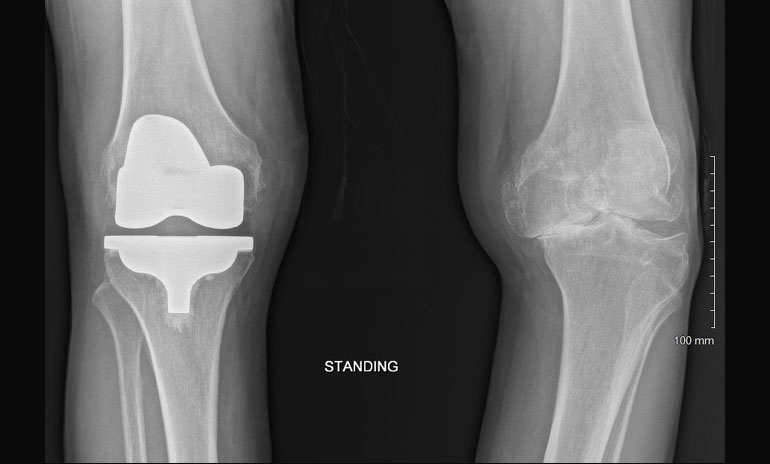Total Knee Replacement
What is a total knee replacement?
Total knee replacement (also called total knee arthroplasty) is a surgical procedure that involves resurfacing of the worn out cartilage in the knee with a metal implant. It is one of the most commonly performed surgeries in all of medicine.

What bones are replaced?
In reality, none of the bones are truly replaced. A more accurate term is resurfacing. The knee is composed of the femur (thigh bone), tibia (shin bone), and the patella (knee cap). In surgery, the worn out cartilage at the end of these bones is removed and replaced with a metal implant. The end of femur is resurfaced with a metal cap. The top of the tibia (or shin bone) is resurfaced with a flat metal tray. A plastic liner locks into the tibial tray and creates a smooth gliding surface for the knee joint. In some circumstances, a plastic button is placed on the knee cap. The functions of these implants are to facilitate movement of the knee and reduce pain.
When is the right time for joint replacement?
This answer is different for each patient. Dr. Kelly’s philosophy of care involves a lot of listening, and then educating the patient about their disease and all the treatment options. Typically Dr. Kelly recommends trying other treatment options first before considering surgery. When those are no longer effective, surgery is discussed with the patient and is often the next step. This is a unique decision for each patient based on the disease severity, as well as their goals and desires in life. Dr. Kelly and his team offer information and support as the patient makes this decision about their own health.
What are the basic steps of total knee replacement?
Dr. Kelly works closely with an anesthesiologist who will make sure the patient remains comfortable throughout surgery. Next, Dr. Kelly makes an incision over the front of the knee to expose the knee joint. The knee is inspected and then the damaged cartilage is removed using a saw and specialized instrumentation. Trial components are placed to test the range of motion and the stability of the knee to ensure the best outcome. Based on this trial evaluation, sometimes changes are made to the bone or soft tissue around the knee. Finally, the bone surface is cleaned off and the permanent metal implants are placed. The joint capsule and then the skin are closed with sutures. The patient wakes up in the operating room and is transferred to the recovery area where the rehab process begins!
What are the risk of surgery?
Complications after knee replacement are rare, but this is still a major surgery that has risks. The main risks are infection, blood clot, pain or stiffness, nerve or blood vessel injury, and wear or loosening of the implant. Dr. Kelly will discuss surgical risk with each patient, depending on each patient’s health status and severity of disease.
How is “Personalized” Total Knee Replacement Different?
Historically, knee replacement was performed the same way in all patients regardless of their anatomy. Studies have shown that patients have higher satisfaction when their knee replacement more closely replicates their normal anatomy. Dr. Kelly takes a personalized approach to each surgery and executes a plan to restore the normal anatomy of each patient. As a result, Dr. Kelly’s patients are more satisfied with the function of their knee after replacement.
What are my restrictions after surgery?
The short answer is: none. Routine running is not recommended after knee replacement to limit stress on the implant; however, occasional running is not a problem. Dr. Kelly’s patients have successfully returned to skiing, tennis, golf, pickleball, bowling, and many more activities.
At a Glance
Dr. Mick Kelly
- Board-Certified Orthopedic Surgeon
- Fellowship Training in Hip and Knee Replacement
- Author of medical publications and numerous textbook chapters
- Learn more
